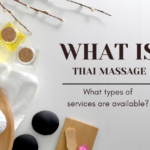Massage therapy is a well-known form of relaxation and stress relief, but with so many types of massages available, it can be difficult to choose the best one for you. Two popular options are Thai massage and oil massage, each offering a unique experience and set of benefits. Deciding between the two depends largely on your personal needs, whether they are physical healing, relaxation, or energy renewal. Let’s take a deep dive into the differences between these two types of massage and which might be best suited for you.

What is Thai Massage?
Thai massage is an ancient healing practice that combines elements of acupressure, Indian Ayurvedic principles, and assisted yoga postures. Unlike most Western massages, Thai massage does not use oils or lotions. Instead, it is performed on a mat on the floor, with the client fully clothed in loose, comfortable clothing.
Technique
The therapist uses a series of stretching movements, rhythmic pressing, and pulling actions to stimulate the energy lines in the body, called Sen lines. These lines are believed to correspond to different parts of the body and affect the flow of life energy (or “Prana”).
During a Thai massage session, therapists use their hands, elbows, knees, and even feet to apply pressure and perform stretches. The session can range from 60 to 120 minutes, depending on the service chosen.
Benefits of Thai Massage
Thai massage offers a range of physical and mental benefits, including:
- Increased flexibility: The yoga-like stretches improve the range of motion in muscles and joints, making it particularly helpful for athletes or people who experience stiffness.
- Improved circulation: The rhythmic pressure and movement help increase blood flow, which can aid in healing and rejuvenation.
- Stress relief: The combination of deep pressure and stretching can release tension in both the body and mind.
- Energy boost: By working on the body’s energy lines, Thai massage is believed to enhance energy levels and mental clarity.

What is Oil Massage?
Oil massage, often referred to as Swedish massage or Aromatherapy massage, is a more relaxing and gentle form of therapy compared to Thai massage. In this type of massage, oil is applied to the skin, and the therapist uses smooth, flowing strokes to manipulate the muscles.
Technique
Oil massage typically involves long, gliding strokes, circular pressure, kneading, and tapping movements, with oil applied to reduce friction. The therapist works on the superficial layers of the muscles using their hands and fingers, focusing on overall relaxation and tension relief.
In an aromatherapy oil massage, essential oils are often added to the massage oil to enhance relaxation, improve mood, and offer additional therapeutic benefits.
Benefits of Oil Massage
Oil massage is primarily known for its soothing and calming effects. Its benefits include:
- Deep relaxation: The gentle strokes and use of oil help create a deeply relaxing experience, ideal for stress reduction.
- Muscle tension relief: Although not as intense as Thai massage, oil massage can still relieve muscle tightness, especially in the back, neck, and shoulders.
- Improved skin health: The use of massage oils hydrates the skin, leaving it soft and smooth after the session.
- Emotional well-being: The calming nature of an oil massage helps reduce anxiety, enhance mood, and promote overall mental relaxation.

Key Differences Between Thai Massage and Oil Massage
- Pressure and Intensity
- Thai Massage: Often described as a more rigorous, intense experience. It involves deep stretching and the application of firm pressure, which can feel quite strong, especially for those not used to it. It is ideal for individuals looking for therapeutic muscle work or for relieving chronic tension.
- Oil Massage: This is a much gentler experience. The pressure applied in oil massage is generally lighter and focused on relaxation rather than deep muscle manipulation.
- Clothing and Oils
- Thai Massage: Performed with the client fully clothed, and no oils are used. The massage is done on a floor mat, which allows for greater leverage in stretching movements.
- Oil Massage: Requires the client to undress to their comfort level and oils are liberally applied to the skin. The massage is usually performed on a padded table.
- Focus
- Thai Massage: Focuses on increasing flexibility, improving circulation, and releasing blocked energy in the body through a combination of stretches, pressure points, and movement.
- Oil Massage: Primarily aims to relax the muscles and mind. The use of oils adds a moisturizing and soothing component, which also enhances the sensory experience.
- Experience
- Thai Massage: Can feel more invigorating and energizing, especially after the session. It’s great for people who prefer a more active form of massage, where you’ll feel stretched and worked out.
- Oil Massage: Leaves you feeling deeply relaxed and calm. The smooth strokes and calming environment make it a perfect choice for those looking to unwind and relieve stress.

What’s Best For You?
The choice between Thai massage and oil massage ultimately depends on what you’re looking to achieve. Here are some considerations to help you decide:
Choose Thai Massage if:
- You prefer a deep-tissue, physically engaging massage experience.
- You have tight muscles or chronic tension, and you’re seeking relief through deep pressure and stretching.
- You want to improve flexibility or work out muscle stiffness after physical activity.
- You enjoy an energizing and invigorating experience that leaves you feeling rejuvenated.
Choose Oil Massage if:
- You are looking for a gentle, soothing experience primarily for relaxation.
- You prefer a calming environment and the use of aromatic oils to enhance the sensory experience.
- You have sensitive skin or muscles that might not tolerate the strong pressure used in Thai massage.
- You want to hydrate and nourish your skin during the massage.
Conclusion
Both Thai massage and oil massage offer incredible benefits for the body and mind, but the right choice depends on your personal preferences and wellness goals. If you’re looking for a therapeutic experience that engages your body with stretching and firm pressure, Thai massage may be your best bet. However, if your primary goal is to relax and soothe your muscles, oil massage can provide the perfect level of comfort and stress relief.
In Singapore, you can easily find qualified therapists and massage centers offering both Thai and oil massages, so you can explore and choose the one that best fits your needs.






